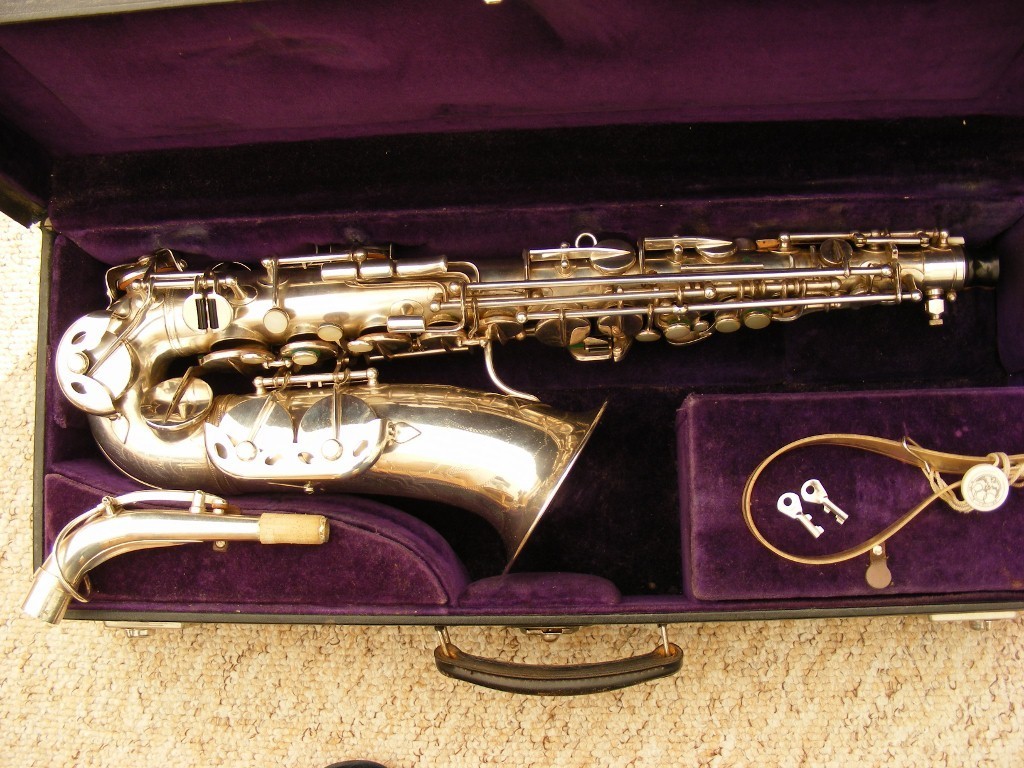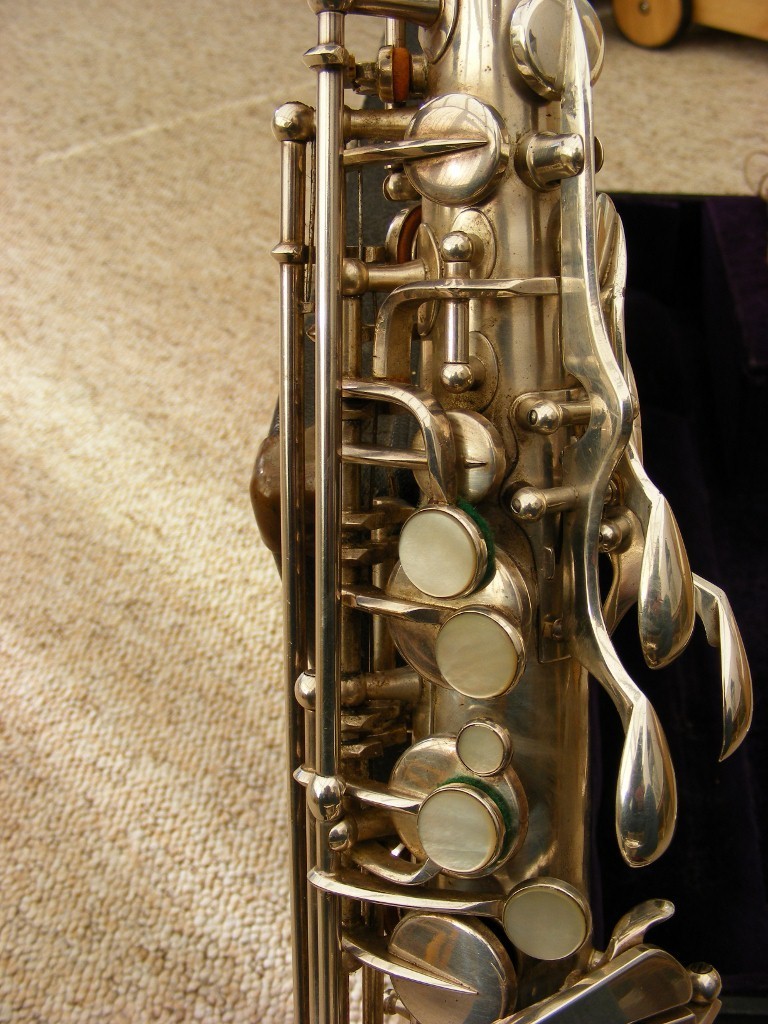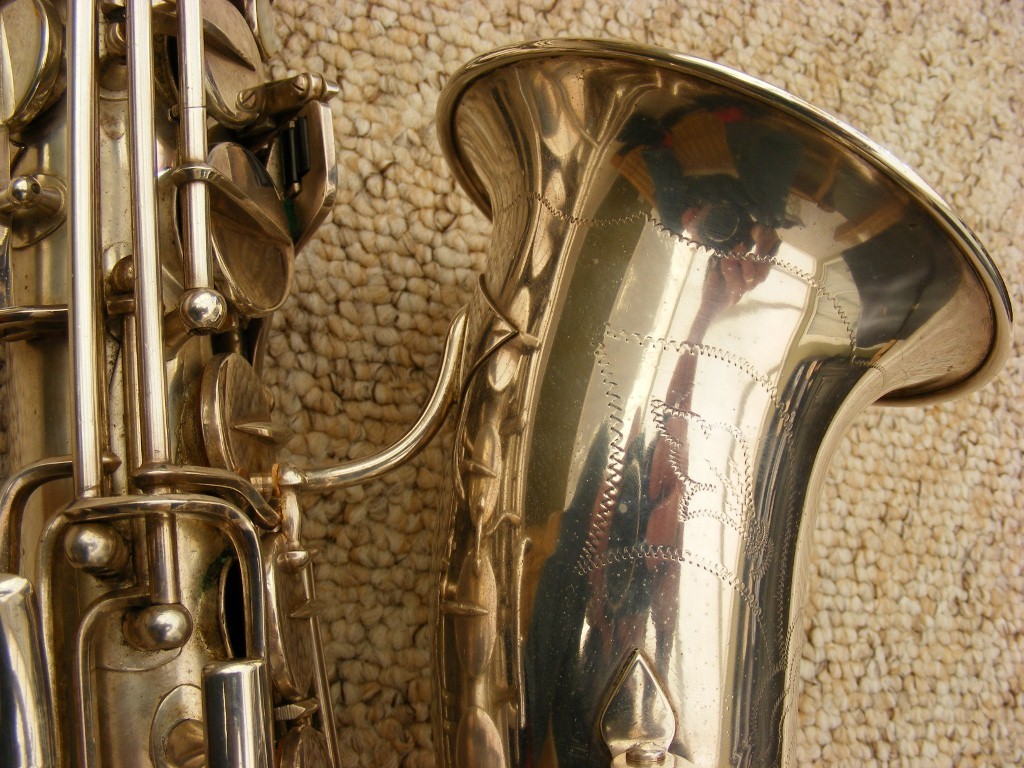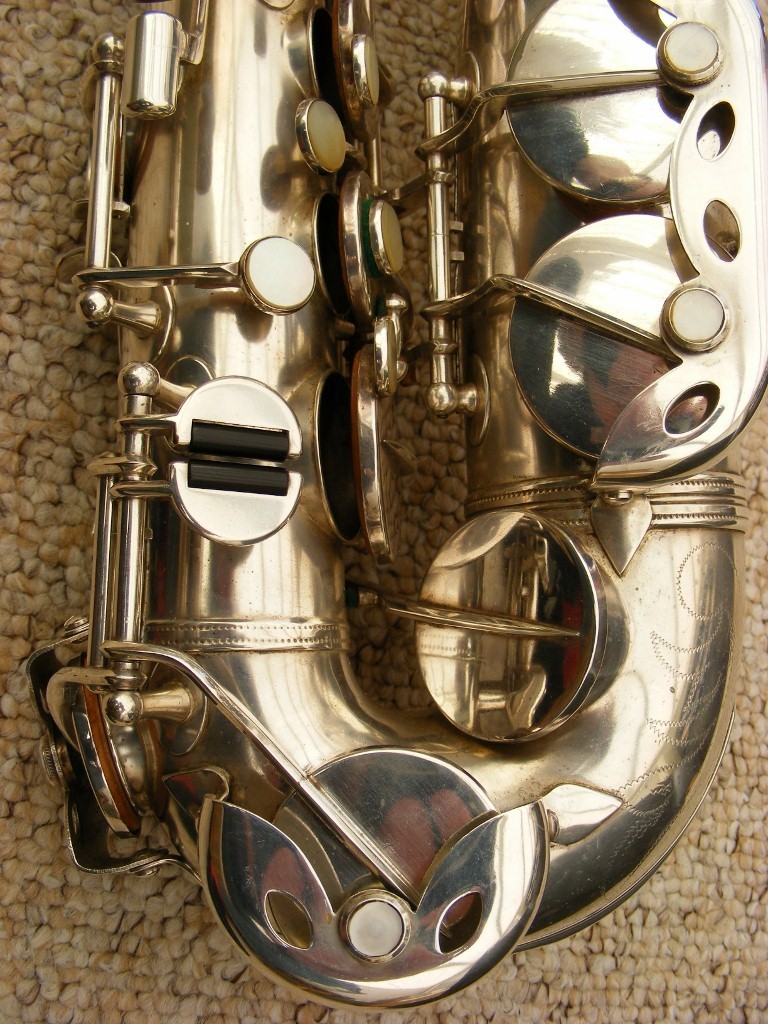A couple of years ago I wrote about a mystery alto sax whose pedigree has remained somewhat of a mystery. The Lafleur Varsity alto, which has ended up living just 30 minutes from me, remains an enigma. Neither I, nor its new owner Kevin, have been able to confirm with 100% certainty where it originated from. (To see the complete set of of photos, see my blog article from March 18, 2010.)
This morning I noticed another interesting Lafleur Varsity alto on eBay. It appears quite a bit newer than Kevin’s sax, and its pedigree is just as mysterious.
Source: andyasw
Source: andyasw
This French-made saxophone is described by its owner like this:
This is my rare vintage Lafleur Varsity alto that bears the inscription: JR LAFLEUR AND SON LONDON PARIS NEW YORK MADE IN FRANCE. It dayes from the 1950s.
It has the serial number 132, rolled tone holes and the unusual right hand G# trill key and mother of pearl touch pieces.
The pads are in excellent order throughout and this easy blowing horn comes from a non-smoking home. The sax was serviced recently and comes with a Buescher case complete with two keys! This sax is testament to the build quality that we seldom see these days unfortunately.
There are no dents to speak of and the silver lacquer is all original and intact. Complete with a truly vintage ROC sax sling too.
I’ll be the first to admit that vintage French saxophones are not my speciality. For me, obscure German brands are more interesting, because comparatively few people have researched them.
Yes, I do know a lot about Pierrets, but really that’s it. I have only limited knowledge about the other French saxophone manufacturers like Buffet, Beaugnier, SML, Couesnon, and the likes.
When I saw this French-made Lafleur stencil horn, with its rolled tone holes, I was intrigued. I’ve been trying to figure out which French manufacturer might have made this horn for JR Lafleur And Son.
Source: andyasw
Off the top of my head, I can’t remember seeing a French saxophone with rolled tone holes before.
The rest of the photos show a horn that is in stunning condition.
Source: andyasw
Perhaps you know who made this horn, and it is exactly what your are looking for. Or perhaps owning a mystery French sax floats your boat. Either way, the auction for this JR Lafleur And Son vintage alto runs until March 4. At the time of writing there was 3 bids on the horn, with the highest being 46.00 GBP—yes, the horn is in the UK. eBay estimates this to be approximately $72.94 US. You’ll have to bid higher, since it is a Reserve Auction, and the reserve price has not yet been met.
Oh, and if anyone knows what this horn is, please chime in and let me know. I’ve been totally frustrated this AM by the Saxpics database not having 1/2 the images in it that it used to have. What’s up with that anyway? Why haven’t they fixed that yet? ![]()












I have just bought a tenor Brass body and keys Lafleur Model Varsity serial number 6193 engraved made in france, Looks about 1952 -58 by the Vinal plastic original case I will post some pictures later, currently freeing up the rollers and will work on it. will try to play it on the old pads just to check the sound quality of tone before a repad. personally looks like a Beaugnier which is why I bought it. your site seems the most informative and accurate so far on a search. The neck looks long and low as a Selmer MK6 which I am happy about as the rest of the body follows a good neck for sound on a saxophone. should be a good project, with a great complex French sound. used to play Pro a 1964 Selmer MK6 which was ok but not great, had a great bottom but that was it frankly.
Interesting. I am interested to see what it looks like.
The mystery continues, but I’ve dug up some new I fo. For starters, the alto that I have (which is a dead ringer for the one in the photos), has been confirmed by several people who know more than I that it is a beaugnier made horn. The body might not have been made by beaugnier themselves, but kitting out by beaugnier. The fact that it has a full set of trill keys is indicative of pre 40’s design as trill keys stopped appearing in the 30s. My technician quoted it being worth around 1000 CAD, in his opinion. He also confirmed that thebperals are, actually, natural and not plastic. Word on the street is that these horns have all the bones of very solid intermediate vintage horns. They play well and beaugnier has something of a cult following in some circles. (I’ve yet to hear anyone malign them and there is one youtuber out there who was completely over the moon that he found one.) Personally, I suspect these are pre war because of two different pieces of evidence. One: my alto weighs almost the same as my modern tenor. I find it hard to credit that any manufacturer would use that much brass on an instrument during the shortages that a war economy brings about. Two: it has THREE different trill mechanisms built into it. These are features that I have it on good authority went extinct during the 1930s. Its possible that it is even older, since the body seems to have been made by a separate company. Beaugnier, I’ve heard, started out making parts for saxophones and didn’t produce a complete saxophone until around the late 1910s or early 20s. The logic would track that early beaugnier bodies could have been made out of house and fitted with beaugnier parts to completion. There’s a lot of speculation in there though and an absolute dearth of hard evidence beyond 2 unicorns stencilled as varsity lafluer and made in france. Sorry for the ramble, if I ever figure out the pedigree of these horns, I swear, I’ll need to write a book.
Glad to get some insight into the alto I picked up a year ago. Has a serial number of 182(?) Though there’s a 4057 above it. Don’t know what that’s about. Definitely enjoying it as a horn even though it has seen better days. Its nice to see what it would have looked like in its glory. I paid 100 CAD for it and I’ve no complaints so far. It feels like an old war horse tbh, but I kind of like that. (Rough, but solid) I just wish there was more info about whether I’ve saddled myself with a classic charger, or classic pinto. I’m not experienced enough to tell at this point, but time will tell.
Thanks for all the comments here. I am preparing to sell my father’s (presumably) Beaugnier-made Lafleur Varsity (also labelled B&H) tenor. He kept it in excellent condition, stored in the period correct tweed case all the time. Where is the best place to sell this instrument? I’ve attached a sub-par cell phone pic.
Hi there.
Well “best place” depends entirely on where you live and how much work you want to put into it.
Personally, I wouldn’t want to deal with sales, so I would talk to a saxophone shop and see about a consignment sale. However, if there is not one near you, then that doesn’t help you much–unless you are willing to ship it.
If you want to sell it locally, there are lots of online options such as Craigs List, or your local paper’s classified section. If on the other hand, you are prepared to ready the instrument for shipping–and doing that takes materials and time to avoid it getting damaged–then eBay is of course always an option. But be aware that a number of people have stopped using eBay because of fees and the possibility of the seller losing money on the sale due to shipping damage, etc, and/or payment being delayed if the seller disputes the sale.
Since I’ not a seller on eBay, this is not really my area of expertise. I am only restating what I’ve read from others who use the online auction site to sell saxophones. I encourage you to do your own research and make sure you understand the implications of any contract you are agreeing to by utilizing their site. (The same holds true of course for any online service.)
I just obtained a Varsity Lafleur. I have had many Beaugnier horns and have never had one with rolled tone holes. However I recognized the left hand table and octave immediately as Beaugnier. Mine needs lots of work but should be fun project
Hi Dave. Welcome to my site.
I believe these Beaugnier-stencilled Varsity Lafleur horns are a fairly rare breed. I have only seen this one, and have heard of only the other one I mentioned that belongs to a fellow who reads my blog regularly. Given how much time I spend looking at vintage saxophones on the web, you’d think I’d have run into at least one or two others over the years.
I’ve never owned a Beugnier sax, but most players who own them seem to quite like them. Enjoy your project. I’m sure you’ll have a fine sax after it’s finished…helen
Remember I sent you the pictures of the British lafluer alto made by the Hammershmidt company which are now on your site? The reason I bought that instrument was because I thought it was a Lafler Varsity I had some time back, only a Tenor, well I was wrong although I dont regret not buying it, but the tenor i had was a Lafluer Varsity which I know was made by Beaugnier ! france
look at the givaway lever on the pinky keys and it was a great tenor that a pal of mine sold me from his pro teacher who rated it nearly as good as the mk 6 tenor my pal bought at the same time. I swapped it and a martin handcraft tenor for my Grafton (Parker’s had just sold at auction for a huge amount and he, my pal wanted the grafton, I have also seen one (varsity)
exactly the same as mine which was I think silver plate but in brass marked as a Boosey and Hawks 400 Tenor, I know it was the same as i had just taken mine into the repair shop and there it was sitting there and my repair guy said ‘oh they are great instruments they are made in france by Beaugnier , yours is the only other i have seen”.
I sold mine a few years back when for health reasons i had stopped playing. I still have the little Lafluer alto, just as a keepsake. I hope this is of some use to you and I would like to wish you all my best wishes and kind regards Dave Laker
Hi Dave. How nice to hear from you again.
Of course I remember you. Your Lafleur alto is so far the only Hammerschmidt-made Lafleur that I’ve seen.
I didn’t realize that you had stopped playing for health reasons. I’m so sorry to hear that. I must admit that I’m not playing as much as I once did either. Before I became ill, I was either practicing, rehearsing, or playing 4 to 5 hours a day. Since developing my neurological condition in Oct. 2006, I only manage a fraction of that.
Rant alert: :rant:
Vintage saxophones are interesting. In my mind, while we might own fine-quality, vintage instruments, we are also more their caretakers. It is our job to preserve them for the future, and ensure that they are good condition for the next owner/caretaker. Too many of these lovely horns have ended up beaten up and trashed. It’s really a shame.
When we think about how many of these (now) historic saxophones we’ve lost because they were perhaps melted down for the war effort, or used for practice in repair schools (think Conn’s F Mezzo-Sopranos), the numbers are just staggering. Add to that all the horns that have just been abused, lost, or tossed in the trash by uncaring persons, and it is quite surprising that there are fine, antique/vintage horns around in playable condition at all. It really speaks to how popular our instrument was, and how many were made world-wide.
Thanks for the visit Dave. I hope you drop in again soon…helen
Update: The auction was pulled by the seller “because the item is no longer available.”
Hi Helen, regarding Kevin’s ‘Lafleur Varsity’ Sax, my vote goes to it being made by Kohlert, similar to their models made in Winnenden ?
Hi, Bob.
I think it’s a good guess to say “Germanic manufacture,” but I don’t think it’s a Kohlert. The Winnenden horns had a much different bell-to-body brace and different keyguards. The neck — you have to go into Helen’s pic archive — is rather distinctive, but looks more like a Hammerschmidt neck than a Kohlert one; although I do agree there are similarities.
Considering it does have “Made in the UK” stamped on the bell, I’d say that you’d might want to look at some of the Hawkes horns, first. I don’t have that much experience with them, yet, so I can’t dismiss them out of hand.
Oh. And not “all sml s had rolled tone holes except ,,gold medal 2.” Many Revisions didn’t have RTH.
Anyhow, I might take a crack at the Lafleur Varsity, later.
There were a lot of French manufacturers that had rolled tone holes: Couesnon, Beaugnier, SML ….
I agree that this one is a Beaugnier. I think the model name of “Special Perfect” is also accurate.
Yes indeed, the mystery is solved. I just received an email from someone in France. That person included 3 photos of their Beaugnier Special Perfect. It is identical to this Lafleur Varsity.
So yes Bob, you are right on the money with that photo link to Kim’s website.
The Beaugnier that have seen in the past are all bass saxophones, and none of them have had rolled tone holes IIRC. Also, the key guards were also not the same.
Mystery solved. Interesting. I wish we could figure out Kevin’s Lafleur Varsity. It and the Hüttl (see link below) from an eBay ad years ago, are likely from the same manufacturer. Now those are oddball horns.
http://bassic-sax.info/4images/categories.php?cat_id=505
Hi all, no, not by SML, or the other French rolled-tone hole suspect Couesnon, but surely is instead by Beaugnier, similar in style to their ‘Vito’ stencil ? Check out this rolled tone-hole beauty @ http://doctorsax.biz/beaugnier_alto_325.htm
Sml stencil?…all sml s had rolled tone holes except ,,gold medal 2